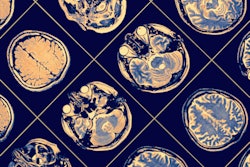
Machine-learning models trained using autopsy tissue samples are revealing new information on brain tumor pathology from MRI exams, according to a May 19 talk at the annual International Society for Magnetic Resonance in Medicine (ISMRM) meeting.
A multidisciplinary research team from the Medical College of Wisconsin reported that their machine-learning models showed promising performance for predicting histopathological tumor features based only on analysis of multiparametric brain MRI studies.
"Generally, these results indicate that our radio-pathomic model can provide clinicians with noninvasive maps of tumor pathology, containing information previously only available via surgical resection," said presenter Samuel Bobholz, a graduate student at the university. "This would allow clinicians to more accurately direct targeted treatments, as maps have been shown to reveal areas of tumor not seen on current MR imaging patterns."
Pathological features of brain cancer include hypercellularity -- indicating an infiltrative tumor -- and pseudopalisading necrosis, which is indicative of tumor regions surrounded by dead cells, according to Bobholz.
"Additionally, necrotic treatment effects are also seen in tumor patients following radiation treatment and are characteristic of their presentation at autopsy," he said.
MRI is commonly used to perform localization and monitoring of brain tumors; pre- and postcontrast T1-weighted images are utilized to define primary tumor mass, while fluid-attenuated inversion-recovery (FLAIR) images indicate peritumoral edema. Apparent diffusion coefficient (ADC) maps show areas of restricted diffusion and hypothesized hypercellularity, according to Bobholz.
"However, in our studies aligning autopsy tissue to clinical imaging, we found areas of proliferative tumor well beyond the contrast-enhancing region, indicating that tumor would likely have been spared during treatment," he said.
In the study, the researchers sought to test their hypothesis that pathological features could be predicted noninvasively from multiparametric MRI.
"The idea being that by using machine-learning models coupled with pathological ground-truth autopsy tissue samples, we might be able to reveal new noninvasive tumor signatures to improve clinical care," he said.
The investigators gathered 93 tissue samples from 44 brain cancer patients and collected T1, T1+ contrast, FLAIR, and ADC images from the last patient's last clinical imaging session prior to death. Of the samples, two-thirds were used for model training, while one-third were utilized for testing.
Next, the researchers then aligned the MR images with the tissue samples as ground truth in order to train three different machine-learning models for predicting cellularity, cytoplasm density, and extracellular fluid density.
After quantitatively evaluating the model's performance, they found that the model yielded the following root mean squared error values on the test set:
- Cellularity: 0.78
- Cytoplasm density: 1.15
- Extracellular fluid density: 0.95
"[These results] generally indicate that our model is able to predict cellularity, as root mean squared error models typically fall within one standard deviation of the ground-truth cellularity distribution," he said.
The model was able to identify regions of heightened areas of cellularity, even in hypercellular areas beyond the contrast-enhanced area of the tumor on the image, according to the researchers. What's more, the other models were also deemed relatively capable of tracking differences in cytoplasm density and extracellular fluid density, respectively.
In future directions for their work, the researchers plan to perform comparisons across diagnostic differences, examine the effects of different treatments, as well as generate tumor probability maps, Bobholz said.




















